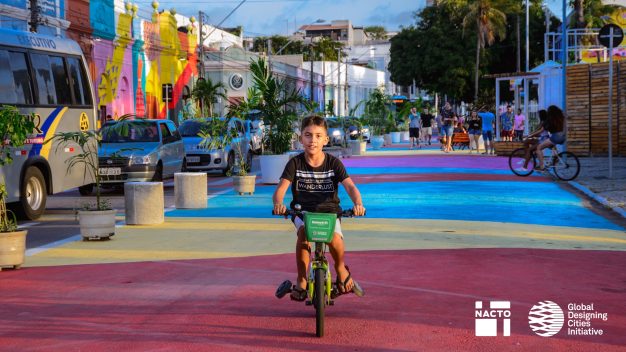
Designing Streets for Kids guide will be ‘global benchmark’ for change
A major new design initiative aims to establish a global baseline for planning urban streets with the needs of children as number one priority.
This new resource, Designing Streets for Kids, is focused squarely on the needs of children and caregivers, and offers solutions and inspirational ideas to make urban streets safer for everyone.
It’s part of the US-based Global Designing Cities Initiative (GDCI), a programme set up by the National Association of City Transportation Officials (NACTO). Based on the principle of putting the needs of people first, this is a fresh focus on the particular needs of babies, children and their carers as pedestrians, cyclists and motorists.
Janette Sadik-Khan, NACTO and GDCI chair, said: “If you design a street that works for kids, you’ve designed a street that works for everyone. Designing Streets for Kids shows how cities can lead by design to improve the quality of life for people everywhere.”
‘If you design a street for kids, it works for everyone’
It highlights how, in general across the globe, most streets were not built with children in mind, and current street conditions in many places are unwelcoming and unsafe for kids. Around 1.3 million people are killed in road accidents every years. Crucially, they are also the leading cause of deaths among young people aged from five to 29.
Urban traffic congestion and the ways in which vehicles are designed are also a significant factor in the context of dangerously high levels of air pollution, which kills over 100,000 children under the age of five each year. Yet many of these deaths could be prevented – not least if child-friendly street design was taken more seriously.
Poor street design also has a detrimental effect on children’s physical and mental health. Noisy, bustling streets often put people off from physical activity, which in turn begins to strip children of their independence and the chance to play, explore and exercise.
Designing Streets for Kids uses diagrams and designs to illustrate and highlight best practices, strategies, programs and policies used globally by cities from Bogotá to Moscow. The guide also focuses on street redesigns in key locations like schools and local neighbourhoods, as well as areas with high traffic levels like commercial streets and busy junctions.

A dedicated chapter on how to bring about change also shows how ideas can be implemented and redesigns scaled-up. Crucially, this includes ‘tactics’ for engaging children in the planning process, an often-underused approach that, says the guide, can dramatically transform how streets are designed and used.
Skye Duncan, Director of NACTO-GDCI, said: “While urban design challenges affect all children, they are especially stark for children in low-income and historically underserved communities. Reliable mobility options and access to safe, healthy streets is a human right, and Designing Streets for Kids provides actionable strategies for ensuring equitable access to these vital public spaces.”
NACTO-GDCI’s Streets for Kids program is supported by a number of organisation dedicated to improving the lives of children, including Bloomberg Philanthropies, the Bernard Van Leer Foundation, the FIA Foundation, and Fondation Botnar:
Susanna Hausmann-Muela, Chief Program Officer at Fondation Botnar, said: “With the widespread closures of schools, daycare centers, and playgrounds due to the COVID-19 pandemic, cities are being challenged to think differently about how play, learning, and social connection can continue to occur for children and young people. Fondation Botnar is committed to supporting the health and wellbeing of children in growing urban environments, and we are proud to support NACTO-GDCI in their ongoing efforts to ensure that children everywhere have the space they need to explore, connect, and move safely around their environment—even in the face of crisis.”
‘Potential for universal application to build better spaces for all’
And “When we take into account the experience of babies, toddlers, and their caregivers in the planning and design of cities, we can better meet the needs of all residents and users of public space,” said Cecilia Vaca Jones, Executive Director of the Bernard van Leer Foundation. “Designing Streets for Kids empowers leaders and communities to consider their city from the eyes of a child, filling a critical gap in urban design thinking and guidance.”
And Saul Billingsley, Executive Director of the FIA Foundation, added: “Every child should have the right to use safe roads, to breathe clean air, and to engage with and participate in the decisions that will impact their future. Cities committed to better environments for their children to play, learn, and live can use this new resource to implement child-friendly urban design. Designing Streets for Kids has the potential for universal application to build better urban spaces for all.”
Designing Streets for Kids can be downloaded for free at GlobalDesigningCities.org.




